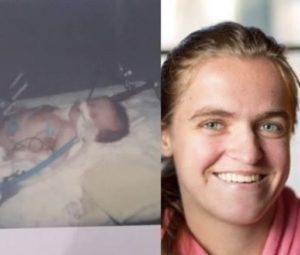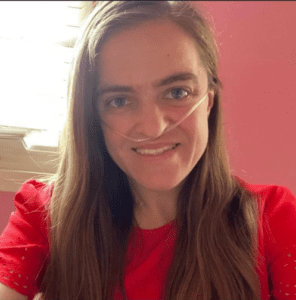At 29 years old, Morgan Nuchols is living the fullest life that she can. She loves challenging herself by doing puzzles. But her favorite activity? Making birthday and holiday cards for her friends and family. It makes her happy to do something sweet and helpful for others; Morgan truly cares about making a difference.
That’s also one of the reasons why she chose to share her story with Patient Worthy. Morgan was born with congenital diaphragmatic hernia (CDH), a rare diaphragmatic defect. Since then, she has also grappled with pulmonary hypertension, gastroparesis, and various other health effects. But to Morgan, raising awareness and supporting others is crucial.
In her story, Morgan explains what CDH is, her diagnostic and life journey, and her advice to others living with this condition.
What is Congenital Diaphragmatic Hernia (CDH)?
Congenital diaphragmatic hernia is a rare condition characterized by a diaphragmatic defect. Normally, the diaphragm separates the abdominal organs from the organs in the chest. CDH occurs when the diaphragm doesn’t close properly during prenatal development. As a result, a baby is born with an absent or partially formed diaphragm. The abdominal organs then herniate into the chest, crowding the heart and lungs, causing underdeveloped lungs, and leading to other potential health issues. Morgan explains:
“CDH can be large or small. In some cases, it is caught before birth. In other cases, it may not be caught at all until the baby is born or until symptoms appear.”
CDH is typically classified by its location/position. For example, 80-90% of CDH are Bochdalek hernias, which are characterized by side or back diaphragmatic defects. Morgagni hernias affect the front of the diaphragm. Doctors believe that a combination of genetic and environmental factors may cause CDH. Symptoms are more common in Bochdalek hernias and can (but do not always) include:
- Difficulty breathing
- Cyanosis (blueish color of the skin and lips)
- Rapid heart rate
- Scoliosis (abnormal spinal curvature)
- Pulmonary hypoplasia and pulmonary hypertension
- Quick breathing
- Abnormal chest development (with one side larger than the other)
- Abdomen appearing to cave inwards
Morgan’s Story
Morgan’s journey with congenital diaphragmatic hernia began at the start of her life. She was born with severe left CDH and placed on extracorporeal membrane oxygen (ECMO) for six days prior to her first diaphragm repair. Between ages 6 months old, almost age 5 then 4th repair at age thirteen, Morgan had numerous other diaphragm repairs; her last took place in February 2007. She also underwent surgery to fix her hernias in 2007 and 2008.

Due in part to her CDH, Morgan also faced several other health concerns throughout her life. As an infant, she had a stroke. Multiple types of seizures later developed, with the latest being in 2015. She had scoliosis, which was repaired in 2006. Though she still has a mild back curve, she’s been stable for 16 years. From birth, she experienced gastroesophageal reflux disease (GERD), though that has since become spontaneous. She also deals with gastroparesis, a disorder which affects the movement of food between the small intestine and stomach. Morgan explains:
“Gastroparesis is actually a very common issue in people with CDH.”
She also had breathing issues, as CDH can cause scar tissue formation and reduced organ growth. Morgan says:
“When I was younger, I knew about my scars but wasn’t aware of the backstory until I got older. I still had as normal of a childhood as I could. But I did need to learn what activities I could do and what I couldn’t. When I was eight years old, I was diagnosed with pulmonary hypertension. I then had to learn how to fill my portable liquid oxygen tank for school, and I brought that with me all the way through my community college courses.”
What is Pulmonary Hypertension?
Pulmonary hypertension refers to abnormally high blood pressure that affects the arteries in the lungs and in the right side of the heart. Over time, pulmonary hypertension can weaken the heart and lungs, causing additional issues. Symptoms can include chest pain, appetite loss, upper right abdominal pain, shortness of breath during exertion, fatigue, and a racing heartbeat.
In Morgan’s case, her pulmonary hypertension (though now stable) was severe. Because Morgan’s left lung was significantly affected by her CDH, it is smaller than average; it’s about 50% smaller than it should be. CDH caused scarring to her lung tissue and air sacs. This had led Morgan to develop chronic bronchitis which also led to and exacerbated her PH.
In 2015, Morgan found and got involved in the PH community. She wanted to learn more about its impact, share her experience, and learn how others coped. In 2016, she attended her first PHA Conference. As she shared pieces of her story, she found that others were interested. Through this networking and discussion, she also learned how CDH and PH connect. Morgan shares:
“CDH connects to pulmonary hypertension in how lungs and air sacs develop. PH can be found in CDH patients after birth. It can improve throughout life, not improve at all, or disappear and then reappear like it did for me. Pulmonary hypertension has many connections to other organs. In CDH, it can be reversed in young patients who are taking PH meds. But for my case, it wouldn’t help at all.”
Sharing Her Unique Story
By the time Morgan turned 25 years old, she had also discovered the CDH community. She felt remarkably supported and learning more about her condition helped her cultivate and share her own story. In 2021, Morgan underwent a chest CT scan to learn more about her lung development. She was able to get a deeper understanding of what muscles she could and couldn’t feel.

Since then, Morgan has done her best to maintain her health while helping others. She shares:
“Right now, my heart is handling my crazy health very well. I do have a 5th small hiatal hernia which could grow. If it does grow, I may need surgery but right now we’re just trying to minimize any growth. I will need new lungs but that won’t be for another twenty years hopefully. For now, I’m working on getting my spontaneous GERD under control and managing my gastroparesis. This requires continuous learning and having to really choose what foods I eat carefully.”
In addition to sharing her experience on Patient Worthy, Morgan also speaks with different families via social media. She messages people on Facebook to provide comfort and advice. When asked what advice she would give to families and patients, she says:
“Keep a close eye on your health. If you show any signs of pulmonary hypertension again, get it checked out. Yearly. Find a doctor or specialist who can manage your care as you transition from childhood into adulthood. And if you’re putting together a medical team, make sure they know about CDH and PH.”






